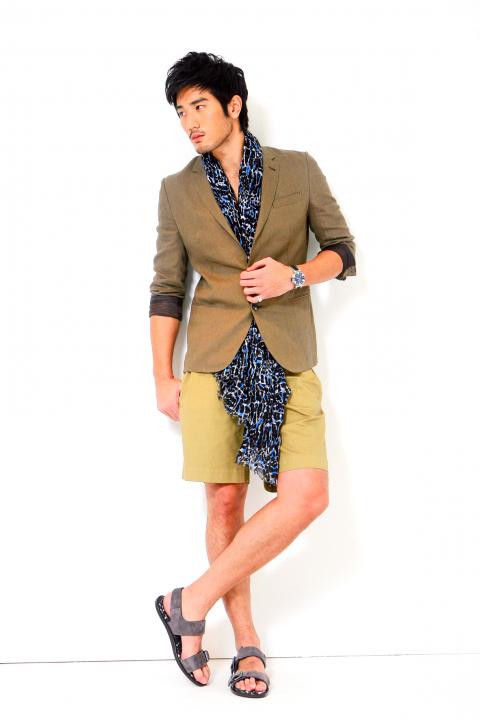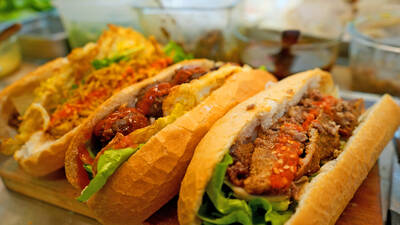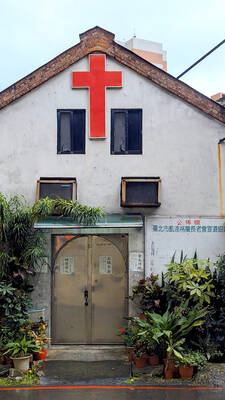The fashion industry has long been criticized for promoting a narrow ideal of beauty: The world’s highest-earning models have been predictably white and blond, led by pneumatic Brazilian Gisele Bundchen, Heidi Klum and Kate Moss.
Which is why the Three Graces chosen to front Estee Lauder’s latest product launch are so arresting: Chinese supermodel Liu Wen (劉雯), Puerto Rican-born Joan Smalls and archetypal French beauty Constance Jablonski. The ad aims to convey that “diversity is beautiful.” The American beauty giant says the campaign is a nod to the late Lauder herself, who apparently had the “unshakeable belief” that “every woman can be beautiful” (the name of the ad campaign).
At the launch her granddaughter Aerin, the company’s creative director, burbled about a new chapter for the 65-year-old company: “Estee’s choice of models throughout the brand’s evolution was always extraordinary ... we continue this legacy with a new group of diverse faces that truly represent a modern vision of beauty.”

Photo: Taipei Times
The message is not new. But the industry’s commitment to reflecting reality is often questioned, with even successful models like Naomi Campbell complaining of racism. She told Glamour magazine two years ago: “You know, the American president may be black, but as a black woman I am still an exception in this business.”
Geoffrey Jones, a Harvard Business School professor and author of Beauty Imagined, says the popularity of the “white, blond and blue-eyed” look has been declining for some time as the global cosmetics industry, in which sales approached US$386.54 billion last year, adapts to the growing markets such as China and Latin America. The latter is expected to overtake North America in size within four years.
“When China first liberalized and cosmetics companies first entered, consumers wanted Western brands because they were associated with success and aspiration,” Jones says. “But in recent years they have become increasingly concerned with the local; they want brands like Estee Lauder or L’Oreal Paris, but they also want them to have a distinctive Chinese appeal.”
The cosmetics industry was battered by the financial crisis, and sales tumbled particularly in mature Western markets — a weakness that has made it all the more important to conquer emerging markets. When he took over this year, L’Oreal’s new chief executive Jean-Paul Agon set the challenge to add a billion new customers in the next decade.
This year fashion editors have been hailing the arrival of the Asian fashion pack, pointing to Liu, who is now the 10th-highest-paid model in the world, as well as Du Juan (杜鵑) — the first Chinese model to appear on the cover of French Vogue — and Godfrey Gao (高以翔), a Taiwanese actor who is the face of Louis Vuitton. Their supposed success has been undermined somewhat by a recent blunder in British Vogue, which confused pictures of Liu and Du in an article about their success.
Sola Oyebade, the chief executive of Mahogany Models Management, Europe’s largest agency for models of color, argues industry power brokers are not convinced of their selling power — although the “black issue” of Italian Vogue in 2008 was so popular that an extra 40,000 were printed.
“I welcome that Estee Lauder has or is attempting to make the brand more visually acceptable to the global market,” he says, but adds: “I don’t think things are changing ... this was a calculated business decision. It is a well known that the economic downturn is having a serious effect on businesses, who recognize that the new and emerging markets are Asia and Africa.”
It is a “good thing” that Asian models are enjoying success, Oyebade says, but even they are few and far between: “When you look at them they are Asian models with strong European features ... without a shadow of a doubt black models face discrimination.”
You only have to look at the luxury goods market to see the pull of Asia: Prada this year opted to list on the stock exchange in Hong Kong rather than in its native Milan on the basis that 40 percent of its sales are already in Asia. The beauty market in China is put at US$4.83 billion and growing fast.
Against that backdrop it is easy to understand the rise of Liu, who has graduated from an average adolescence of homework and ping pong in Yongzhou, a city in Hunan Province, China, to international stardom. She got her big break in 2005 when her mother entered her in a modeling competition to stop her slouching. Since then she has become the first Chinese Victoria’s Secret girl and the first on Estee Lauder’s roster of “brand ambassadors.”
Now based in New York, she has worked on her English by watching TV and films — particularly the teen vampire saga Twilight. She told one interviewer recently: “I didn’t think before that an Asian girl could do a beauty campaign. I do the campaign for the world, not only for Asia,” she added, reinforcing her achievement. In China, Liu is not considered a “classical” beauty; the desired aesthetic is a doll-like face with big eyes and pale skin. That beauty is in the eye of the beholder is a truism the beauty giants are all too aware of as they cash in on the hang-ups of different races.
Estee Lauder’s larger rival L’Oreal spends more than US$966.24 million a year developing products to feed consumers’ hunger for new shampoos and lipsticks. It has more than a dozen “evaluation centers” around the world where, according to Patricia Pineau, its head of communication for research and innovation, it studies the idiosyncrasies of national beauty routines in mocked-up bathroom sets: “We ask women to come with their beauty case and we observe.”
The results are surprising. “A Korean woman uses 23 products and will spend 45 minutes getting ready,” Pineau says. The lengthy session in front of the mirror involves the painstaking use of eyeshadow to “design a double eye to make eyes look more open.” One study revealed that women in Mexico City, where hair loss is a side-effect of pollution, crush contraceptive pills in their shampoo to aid hair growth.
When Lauder started building a cosmetics empire in the second half of the 20th century, only Hollywood actors and the French had global appeal. That is no longer true today and Leonard Lauder, the founder’s son, who is credited with transforming the family firm into today’s near US$8.05 billion business, talked of the arrival of “beauty pluralism” in an interview with Women’s Wear Daily. He described a “wave” of Chinese consumption at home and abroad, with almost half the cosmetics sold in Galeries Lafayette bought by tourists. “The Chinese are going there,” he said. “The Russians are coming to London. The people from the Middle East are coming to London. You advertise the right products with the right models in the right country.”
L’Oreal has 25 faces, including Ethiopian model Liya Kebede, Beyonce and Aimee Mullins, athlete and double amputee. “We aim to show a depth of personality, not just a beautiful face,” says Gayle Tait, UK general manager for L’Oreal Paris. Some stars, such as Cheryl Cole in the UK, have local contracts, while others, including Beyonce and Bollywood’s Aishwarya Rai, feature in global campaigns.
The “every woman can be beautiful” ads are showcasing a range of face creams deemed suitable for all skin tones, but Estee Lauder is the owner of a cupboard full of brands including Clinique, Bobbi Brown and Jo Malone, and is not pushing a “one size fits all” approach. Last month it opened a research center in Shanghai to reinforce its “strong commitment to local consumers by developing products tailored to the specific needs of Chinese and Asian skin.”
Skin whitening creams, for example, are big business for women and men in Asian markets. In India alone, the desire for fair skin has created a US$483.1 million a year trade in creams led by Unilever’s Fair & Lovely. Estee Lauder’s products include Cyber White Lightening lotion.
The altered image of the beauty industry is also about change closer to home, Jones says. “Major Western markets have become multiracial in a way they weren’t 10 to 20 years ago and using models of different ethnicities is a way to hit those markets big time.”

Following the rollercoaster ride of 2025, next year is already shaping up to be dramatic. The ongoing constitutional crises and the nine-in-one local elections are already dominating the landscape. The constitutional crises are the ones to lose sleep over. Though much business is still being conducted, crucial items such as next year’s budget, civil servant pensions and the proposed eight-year NT$1.25 trillion (approx US$40 billion) special defense budget are still being contested. There are, however, two glimmers of hope. One is that the legally contested move by five of the eight grand justices on the Constitutional Court’s ad hoc move

Stepping off the busy through-road at Yongan Market Station, lights flashing, horns honking, I turn down a small side street and into the warm embrace of my favorite hole-in-the-wall gem, the Hoi An Banh Mi shop (越南會安麵包), red flags and yellow lanterns waving outside. “Little sister, we were wondering where you’ve been, we haven’t seen you in ages!” the owners call out with a smile. It’s been seven days. The restaurant is run by Huang Jin-chuan (黃錦泉), who is married to a local, and her little sister Eva, who helps out on weekends, having also moved to New Taipei

The Directorate-General of Budget, Accounting and Statistics (DGBAS) told legislators last week that because the Chinese Nationalist Party (KMT) and Taiwan People’s Party (TPP) are continuing to block next year’s budget from passing, the nation could lose 1.5 percent of its GDP growth next year. According to the DGBAS report, officials presented to the legislature, the 2026 budget proposal includes NT$299.2 billion in funding for new projects and funding increases for various government functions. This funding only becomes available when the legislature approves it. The DGBAS estimates that every NT$10 billion in government money not spent shaves 0.05 percent off

Dec. 29 to Jan. 4 Like the Taoist Baode Temple (保德宮) featured in last week’s column, there’s little at first glance to suggest that Taipei’s Independence Presbyterian Church in Xinbeitou (自立長老會新北投教會) has Indigenous roots. One hint is a small sign on the facade reading “Ketagalan Presbyterian Mission Association” — Ketagalan being an collective term for the Pingpu (plains Indigenous) groups who once inhabited much of northern Taiwan. Inside, a display on the back wall introduces the congregation’s founder Pan Shui-tu (潘水土), a member of the Pingpu settlement of Kipatauw, and provides information about the Ketagalan and their early involvement with Christianity. Most